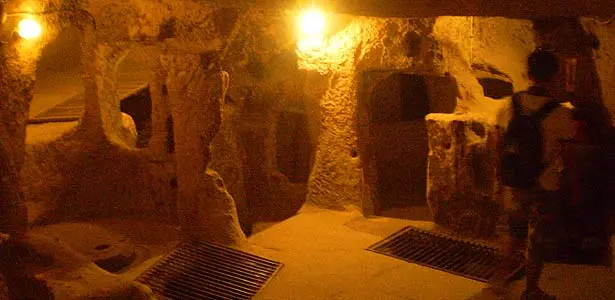Looking around at the stone cave walls carved out of volcanic ash rock, I smelt dampness in the air. It overwhelmed me and accompanied by an acute sense of claustrophobia, I followed the sign-posted path leading out of what was a chapel into another room used as a winery.
I was in Mazi underground city in the Cappadocia region of central Anatolian Turkey. The area is abundant with cave churches but can also boast about hundreds of ancient underground cities with complex networks of tunnels and rooms that stretch for miles.
Used for safety during the Byzantine period till the 14th century, when armies invaded, the local citizens fled to the underground cities with their livestock and stayed there till the threat went away and in some cases, this was up to a year at a time.
The tunnels are impressive evidence of the lengths that mankind will go to, simply to survive. They were also a test of endurance for social living and what man treasures most; sanity.
My guide answered questions from another member of the tour group, about what would have happened if someone had gone crazy.
“This was a strong possibility” said my guide. “Man has always walked the earth with natural daylight and the sense of the sun on his skin. We enjoy looking up at the bright-blue sky, not four walls of a cave. We like to hear the birds sing, see the flowers grow and swim in water”
Anyone with an ounce of compassion would feel for someone who lost their mind but unfortunately, the only options available were to tie them up like cattle so they couldn’t escape or if the risk was too great, they had to kill them. After all, if they made it to the surface, invaders could torture them to reveal how to get into the city. They not only risked their own lives but also other citizen’s well-being and this was the safest option.
In reality, Mazi underground city is relatively small compared to the others of which the most famous is Derinkuyu.

About Derinkuyu Underground City
This impressive man-made structure from the past stretches to roughly 60 metres below ground level and includes 11 floors, although not all of them are open to the public. The huge complex of winding tunnels and rooms carved out of the rock housed 20,000 people along with their livestock and belongings.
During construction, every aspect needed to live a normal life was built, including a 55 metre ventilation tunnel, water wells and a large-circular stone door that could only be opened and closed from the inside.
Discovered by accident in 1963, when a local man was renovating his house, the complex also contained a school, chapel and cemetery because even the dead were accommodated for. Naturally if a community lived underground for six months, a strong chance of natural death or sickness existed. They stored them in locked rooms because of the odour oozing off dead bodies and the potential ability for disease to spread.

The Latest Underground City to be Discovered
For many years, Derinkuyu has been the king of all underground cities, but the discovery of another city that rivals its size, could knock it off its throne.
Discovered completely by accident in 2013, when construction workers demolishing low-income housing, near the castle of Nevsehir, came across entrances to a complex of tunnels, the underground city amazed officials and they halted the construction work while calling in archaeological experts.
By 2014, they had discovered every structural aspect that citizens of a city need to survive including linseed presses to produce oil for the underground lamps.
This newly discovered city matched Derinkuyu in that it had a chapel, storage rooms for grain and livestock as well as staircases, bedrooms and stairs, connecting all the levels together.
Conspiracy theorists often remark that civilisation could never have so intensely and with extremely exact precision, constructed these underground cities. Their biggest evidence is the lack of modern machinery they had in those days, and how long it would have taken, for even a large community of men.
They instead prefer to credit aliens with the concept and notion, but no evidence of extra-terrestrials has ever been found in the cities. Historians confirm that their creation is simply the work of humankind when we want to live on to see another day.
Travel Advice: Anyone can see the underground cities of Cappadocia, because about 40 including Derinkuyu are open to the public but if you suffer from claustrophobia, panic attacks, dizzy spells or heart disease, the authorities advise against it.









 Kalkan
Kalkan  4
4  4
4 


















 X
X